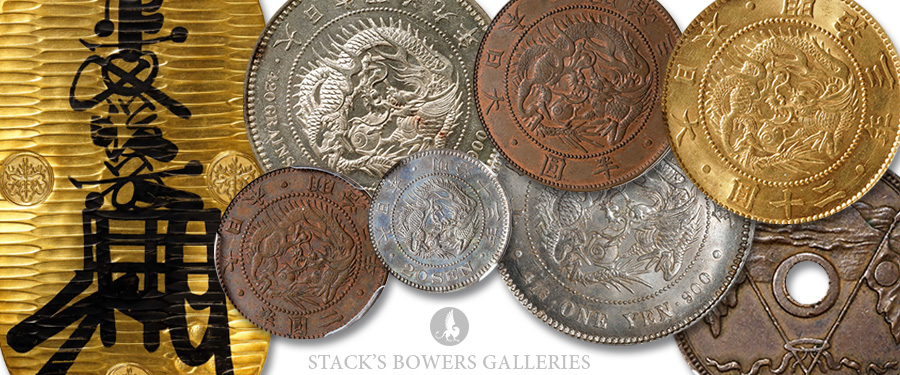
The Stacks Bowers and Ponterio May 2022 Hong Kong auction will offer a large assortment of numismatic treasures from across Asia. In the Japanese section of the sale, rare and premium examples from both the Shogunate and the Empire eras abound.
During the period between 1853 and 1905 Japan underwent massive change on all levels of society. In 1853 Japan was forced to end its policy of isolationism after the United States sent Commodore Matthew Perry to open its ports to trade. This event sparked the realization that Japan was in danger of colonization by Western powers. In 1868 Japan restored imperial rule and formally ended the Shogunate, with initiatives to industrialize, modernize, and westernize to compete with traditional European powers and the United States. By 1905 Japan had become a major world power, capable of defending itself from Western powers, as confirmed by Japan’s victory over Russia in the Russo-Japanese War.
Japan’s program of industrialization also involved a complete overhaul of the monetary system. Prior to the Meiji restoration, Japan utilized the Tokugawa monetary system, with separate denominations for gold, silver, and bronze coins. This system birthed one of the most visually impressive and striking pieces in our entire sale; an Oban (10 Ryo) from the Man’en Era graded MS-63 by PCGS (lot 56017) and with a provenance to the Mark and Lottie Salton Collection. This large plate of electrum, a mixture of gold and silver, was the highest denomination in the Tokugawa monetary system. Weighing over 112 grams, these large pieces were initially produced mostly for export to pay for luxury goods, though by the time this piece was produced in the 1860s, specie had been banned from export from Japan. The example available in the May auction was the among final Obans produced by Shogunate Japan.
By 1867 Japan had decided to abandon the old monetary system in favor of a new decimalized currency to be produced at a new Japanese Mint. Osaka was chosen as the site of the new coining facility, with regular production beginning in 1871, though coinage was likely struck starting in December 1870. The name and composition of the new currency was to be decided in the intervening time. In this period, Japan contracted out patterns from the Heaton Mint, one of which was an 1869 Monme, graded PCGS AU-53 (lot 56097), a large sized bronze pattern named after an old Japanese weight standard. This denomination was rejected, and the Meiji government instead adopted the Yen which was subdivided into 100 Sen and 1000 Rin. Among the first issues denominated in the new Yen were several patterns that were produced in unadopted denominations. The May auction features two of these patterns both from Year 3 (1870), a 2 ½ Yen (lot 56098) and a ½ Yen (lot 56099), both in bronze and graded by PCGS as Specimen-63, with the ½ Yen receiving a Red-Brown designation. Both patterns are exceedingly rare, with very few examples surfacing on the secondary market. These two pieces are among many extremely interesting patterns offered in the May auction.
An extremely strong offering of key date circulation strikes includes a Year 3 (1870) 20 Yen graded PCGS MS-64 (lot 56019) also from the Mark and Lottie Salton Collection. This early 20 Yen series minted between 1870 and 1892 contains some of the most desirable issues in the Japanese series. Also of note is an amazing Year 8 (1875) Yen certified MS-63 by PCGS (lot 56048), a date that is the hardest to find in the entire Yen series. This Yen is the finest of only two Mint State examples certified by PCGS, and the nearly impossible task of finding another makes us expect strong bidding, with this example estimated at $50,000-$100,000.
A final category of special strike quality pieces is highlighted by a Year 9 (1876) Trade Dollar graded NGC MS-62 Prooflike (lot 56081). The short-lived Trade Dollar is a popular mainstay of Japanese numismatics, though issues with a prooflike finish are extremely rare. No Proof striking is recorded, though these prooflike examples are clearly distinguished from the normal circulation strikes and were likely specially struck. Also falling into the category of specially produced coins is perhaps the highlight of the entire Japanese section, a Year 13 (1880) 20 Sen Proof graded Proof-62 (lot 56088). This piece is from a Proof set that was likely created as gifts for dignitaries, and no complete sets remain intact today. Though the mintage is recorded as 96, the survival rate for this piece is likely far lower, with perhaps fewer than 10 remaining. Given the extreme rarity of the piece, it would not be surprising to see this example exceed the estimate range of $70,000-$100,000.
These highlights, along with over 7,500 other Asian related coins will be available for viewing and bidding at StacksBowers.com. We are always seeking world and ancient coins, medals, and paper money for our auctions, and are currently accepting consignments for our August 2022 Global Showcase Auction and our October Collectors Choice Online (CCO) sale. If you would like to learn more about consigning, whether a singular item or an entire collection, please contact a consignment director or email info@stacksbowers.com today and we will assist you in achieving the best possible return on your material.





